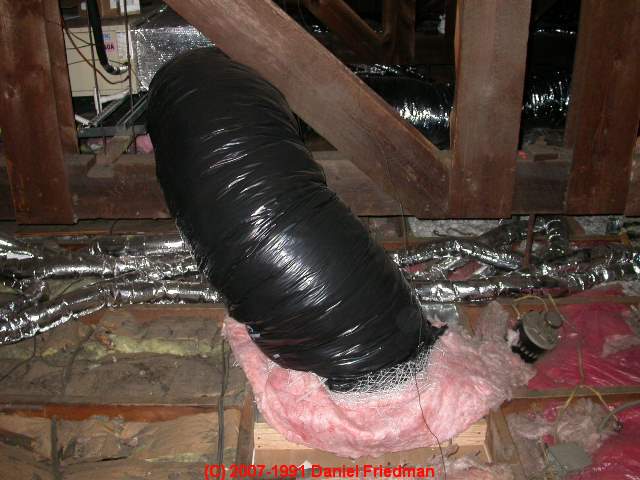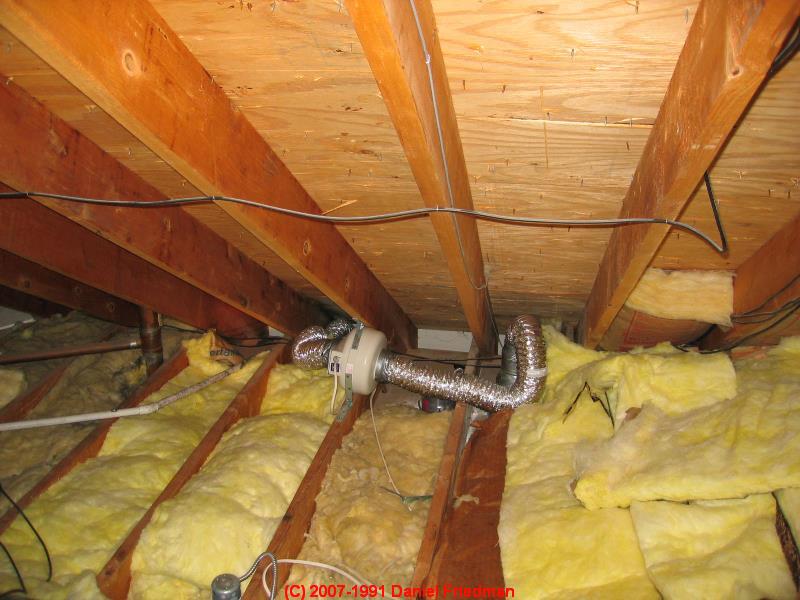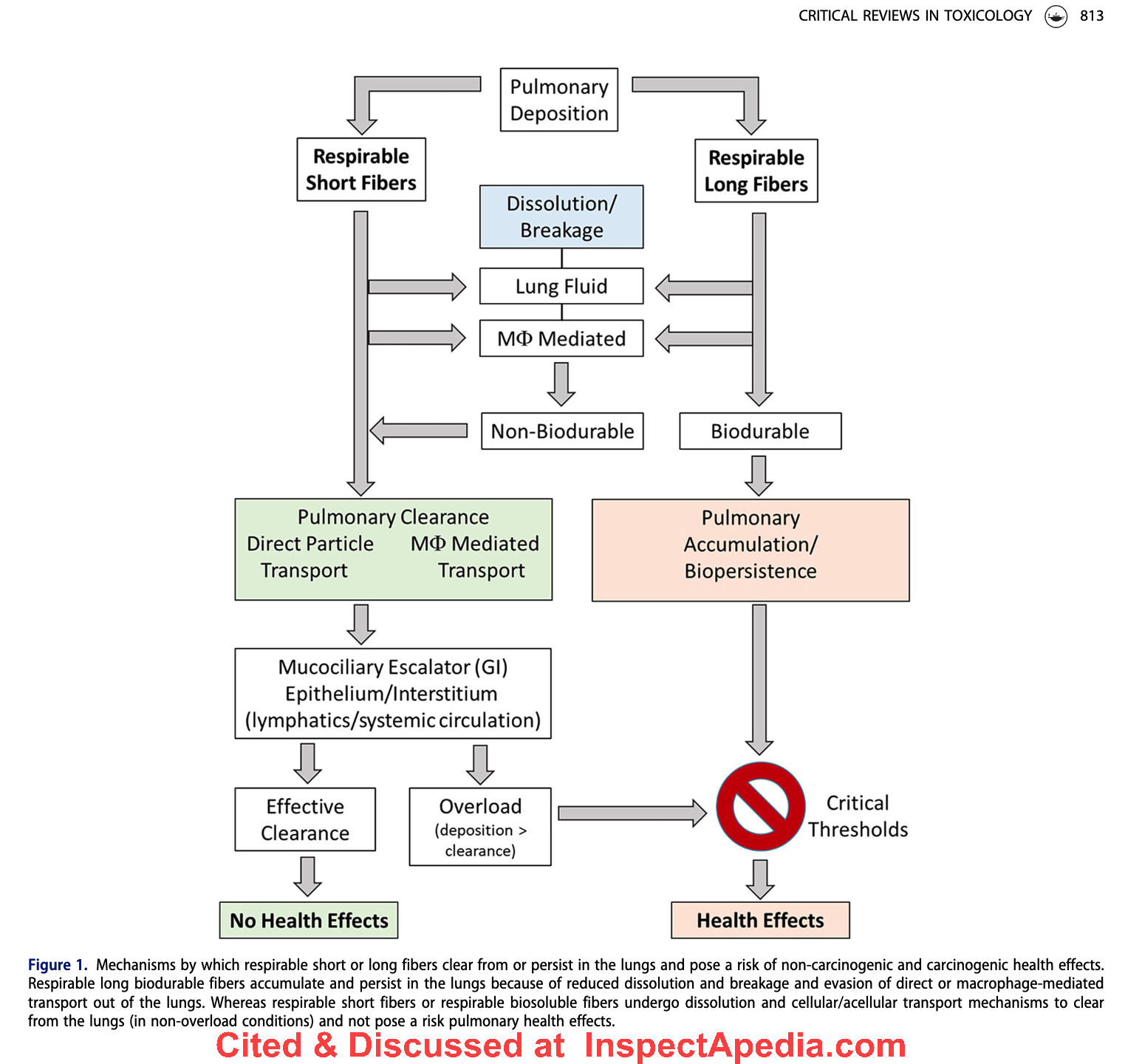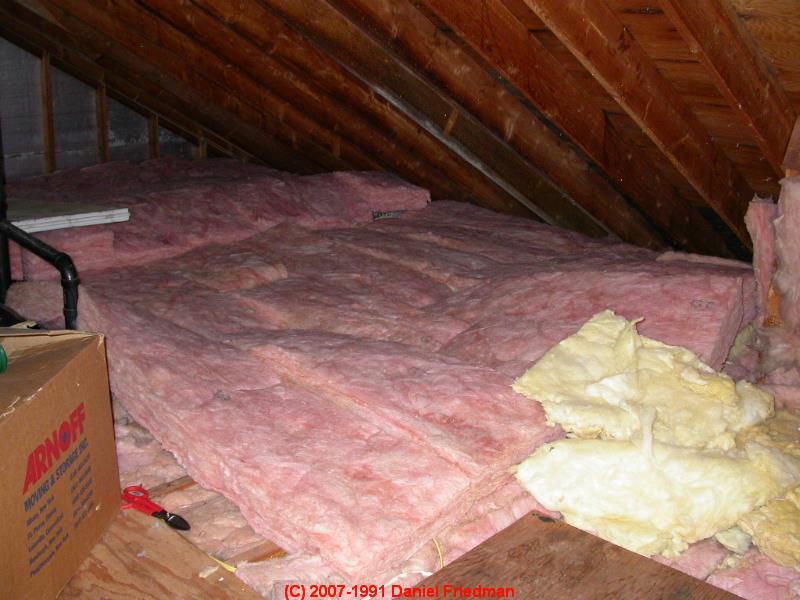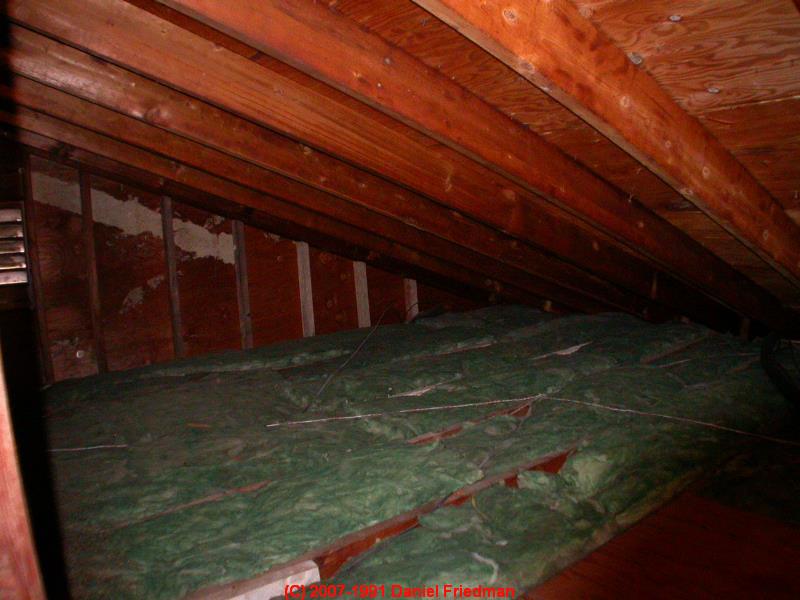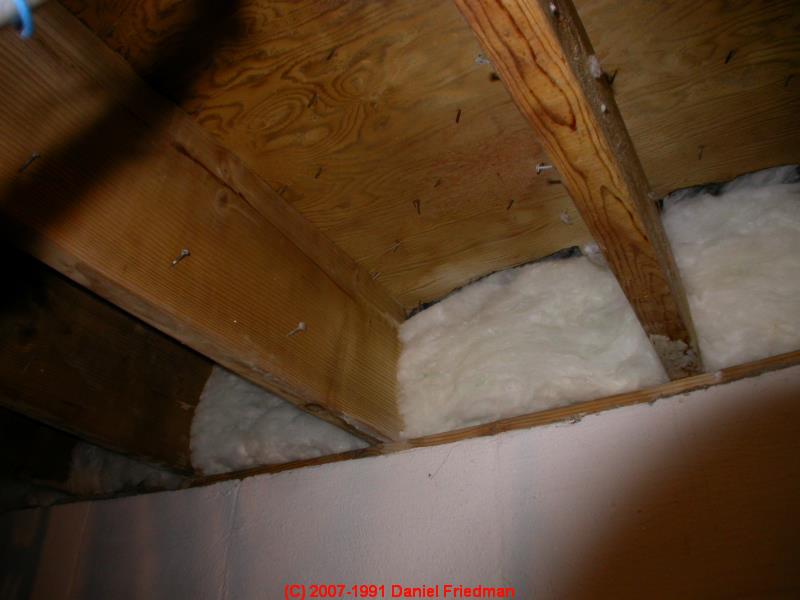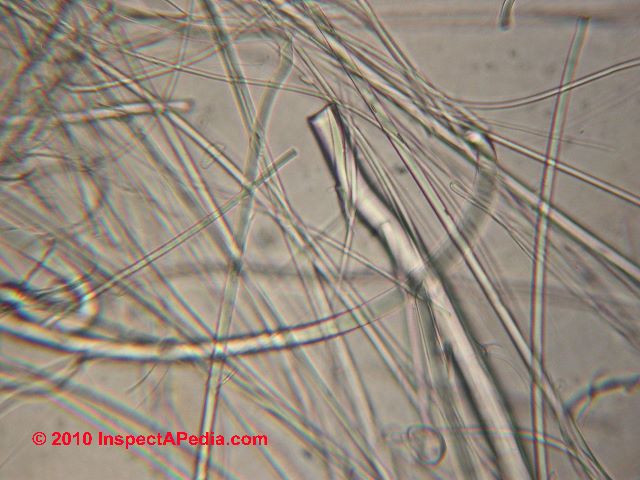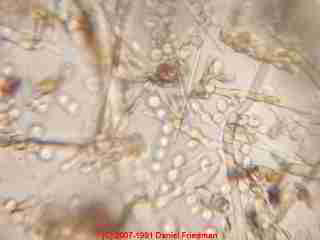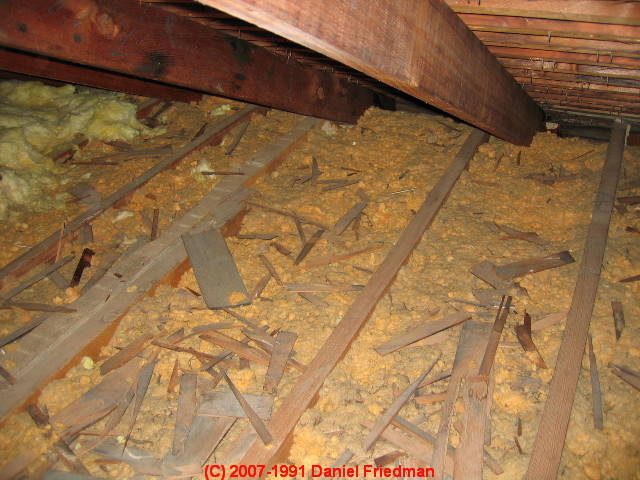 Fiberglass Hazards Buildings
Fiberglass Hazards Buildings
Home Page & Article Index
- POST a QUESTION or COMMENT about fiberglass dust, particle, & mold hazards in air, dust, ducts, and buildings
This article series provides information about how to identify fiberglass insulation in buildings and fiberglass hazards and fiberglass insulation contamination issues in residential and light-commercial buildings.
We also discuss proper practices for installing, inspecting, and where necessary, repairing fiberglass building insulation.
Note: as we document on our FIBERGLASS HAZARD RESEARCH page, the research literature is replete with studies indicating that there are no health hazards associated with airborne fiberglass particles, and with a other studies reaching quite the opposite conclusion, that breathing fiberglass fibers can in at least some circumstances, become a serious health hazard.
Bottom line: Our OPINION is that prudent avoidance of inhaling fiberglass dust and using damp wiping and HEPA vaccuming to clean up significant levels of such dust in occupied spaces would be in order.
We recommend that readers examine carefully the methodology used in such studies, the expertise of the researchers, and the sources financing of such work.
InspectAPedia tolerates no conflicts of interest. We have no relationship with advertisers, products, or services discussed at this website.
- Daniel Friedman, Publisher/Editor/Author - See WHO ARE WE?
How to Identify or Recognize Fiberglass Insulation in buildings
Here we discuss the following: What does fiberglass building insulation look like & what are the colors of different brands of fiberglass insulation?
Where else do we find fiberglass in buildings besides floor, wall and attic insulation?
What are the Problems with Identifying Fiberglass Hazards in buildings? Microscopic identification of fiberglass insulation fragments,
Health concerns of fiberglass exposure, Mold hazards in fiberglass insulation,
Fiberglass exposure hazard reference list, Fiberglass insulation demolition mess, itching, dust persistence
Based on literature review as well as both field and laboratory experience, it is reasonable to claim that large particles of fiberglass are far more likely to be a respiratory or skin irritant than a carcinogen or other more serious health hazard.
However some of our field and lab inspections detect very small, even sub-micron sized particles which are traced to building insulation.
Studies by experts have pointed alternately to large fibers as more hazardous and others to small fragments of fiberglass as more hazardous.
The illlustration above was developed by Madl (2022).
Madl, A. K., & O’Neill, H. C. (2022). Fiber biodurability and biopersistence: historical toxicological perspective of synthetic vitreous fibers (SVFs), the long fiber paradigm, and implications for advanced materials. Critical Reviews in Toxicology, 52(10), 811–866. https://doi.org/10.1080/10408444.2022.2154636 - local copy saved as Fiber-biodurability-SVFs-Madl.pdf
Of course "large" and "small" need to be defined in each of those cases.
In our OPINION both large AND much smaller particles may indeed be a health hazard, as indicated as well by Madl.
Watch out: based on our own field and lab experience, very small fiberglass fragments may be entirely omitted or simply missed by some laboratories charged with reporting on the level of fiberglass in building air or dust.
In field and laboratory experience with dust collection and characterization and in reviewing other environmental test reports we have found that small particles in the PM1 or smaller range are most-often not reported and we think were not looked-for, not collected, or simply not identified by the lab procedures used.
It is possible that by failing to screen for and detect any particle during environmental testing or health studies, the effects of those particles are under-stated or missed entirely.
See details at FIBERGLASS DETECTION in BUILDING AIR & DUST
This article explains the recognition of types of fiberglass insulation in buildings, other fiberglass particle sources, and some possible health concerns that involve these materials.
What does fiberglass building insulation look like & what are the colors of different brands of fiberglass insulation?
Fiberglass building insulation is commonly installed in batts or chopped forms and may be yellow, pink, green, or white in color as is shown in these photographs.
While this material is not and should not be confused with asbestos nor with the well-studied health hazards associated with exposure to asbestos fibers or dust, our separate article on Airborne Fiberglass Building Insulation Hazards [link just below] and HVAC duct work insulation hazards contains additional discussion about possible air quality and health concerns which may be associated with exposure to fiberglass dust.
See FIBERGLASS FRAGMENT HAZARDS in AIR or DUST
Where else do we find fiberglass in buildings besides floor, wall and attic insulation?
Fiberglass duct insulation material appears in several forms in heating and air conditioning systems in both ducts and air handlers themselves.
The most common uses of fiberglass insulating material in HVAC systems includes the cases listed below.
The annotated duct system photographs shown in the article cited below will permit any careful observer to identify the most common types of fiberglass HVAC duct materials.
We provide these (C)-protected photographs of fiberglass insulated ducts and HVAC components to aid in recognition of these materials.
Our detailed article on how to recognize fiberglass duct insulation and its characteristics and hazards can be read in its entirety
What are the Problems with Identifying Fiberglass Hazards in buildings?

Special challenges face consumers requesting lab services for identification of fiberglass fragments in air, dust, or material samples are easily identified in the forensic laboratory using light and polarized light microscopy and common slide preparation techniques.
Our photograph (left) shows a typical fiberglass insulation fiber with droplets of resin binder attached. It's easy to identify large fiberglass fibers in transmitted-light microscopy.
But identification of very small fiberglass fragments in a building dust or air sample can be difficult to detect unless the microscopist is trained and looking for that material, and special methods such as use of phase contrast may be needed.
Binder Resins in Fiberglass Insulation Help Trace Source
Observing the color of a fiberglass bonding resin can help trace particular fiberglass in a building air or dust sample back to its source.
Other fiberglass products, such as this Certainteed un bonded blowing wool (fiberglass) lack a characteristic resin.
Interestingly in this client-provided sample of nearly-new blown-in fiberglass insulation we found very few small fiber fragments. Dust tested from that home was also low in fiberglass fragments.
The common errors which result in failing to detect small fiberglass particles in building air and dust are discussed in detail
at LAB IDENTIFICATION OF FIBERGLASS
In that article we also discuss techniques which permit the forensic microscopy lab to identify the source or reservoir of particular fiberglass fragments in a building, sorting out among many possible fiber sources to pinpoint the particular problem such as damaged building insulation, damaged HVAC duct work, or other particle sources.
We also discuss how to distinguish among types of insulating and other fibers, comparing various types of fiberglass insulation, mineral wool insulation, asbestos insulation, and other fibers.
Also see FORMALDEHYDE in FIBERGLASS INSULATION - some fiberglass resin binders use formaldehyde.
Frequent presence of fiberglass fragments in air and some dust samples, suggests that an HVAC duct system or exposed fiberglass insulation in the building may be contributing unwanted and potentially unsafe levels of these fibers. This discussion can be read in its entirety
at FIBERGLASS DETECTION in BUILDING AIR & DUST.
Also see INSULATION PRODUCTS MSDS
and FIBERGLASS INSULATION EXPOSURE LIMITS.
Moldy fiberglass insulation
We have also detected high levels of problematic mold in fiberglass building insulation where other mold reservoirs were either not present or had been previously removed.
This article can be read in its entirety
at MOLD in FIBERGLASS INSULATION
Reader Question: Continued Itching after Fiberglass Demolition
I have a question regarding fiberglass insulation. I pest control worker, who is trying to rid us of rats in the attic, removed the fiberglass insulation from the attic space but dragged the insulation through the house. Now, we are constantly itching. Is is due to fiberglass particles in the air?
What can we do? We've vacuumed a lot but it's not helping. Help! Thank you for your time, M & M.
Reply: clean up, wash, laundry clothing, check with your doctor, consider dust testing
A competent onsite inspection by an expert usually finds additional clues that help accurately diagnose a problem such as incomplete cleaning, or some other problem source yet unnoticed, including a biological hazard associated with the rodents themselves.
In addition to consulting your doctor who may in turn decide to refer you to a dermatologist, you might also benefit from reviewing
the ITCHING & SCRATCHING RESEARCH found in
our article concerning MORGELLONS SYNDROME.
That said, here are some things to consider about itching after messing with fiberglass insulation:
Dragging fiberglass refuse through a building causes dust contamination
Dragging fiberglass through a building is likely to have left a fair amount of broken fiberglass fragments on floors and through air transport, as settled dust on surfaces
. If you haven't done so you may want to clean the rooms through which insulation was dragged using damp wiping and then HEPA vacuuming of all surfaces, especially floors, carpets and any nearby furniture, shelving, etc.
Continued skin irritation after handling fiberglass insulation
It can take two or in a few cases even three trips through the washing machine to remove enough fine insulation fragments from clothing that it would not any longer be irritating to your skin
In my experience, working with insulation, especially during demolition when lots of material is broken up and airborne, the skin itching can last for a day or two after the work has been completed.
Taking a couple of showers, washing fully, may remove the dust, debris, and fiber fragments, or nearly all of them, from your person, but the skin may have become irritated, taking a bit longer to recover.
Check with your doctor if skin irritation continues past 1-3 days.
If itching continues after you've cleaned yourself, clothing, and any dust left in the building (use a HEPA vacuum when vacuuming up fine dust), then I suggest checking with your doctor or a dermatologist.
Consider dust sampling if you are not sure the building cleaning was adequate
If you have reason to suspect that there remains irritating dust and an irritating dust source in the building, I'd consider collecting one or two tape samples of settled dust from a horizontal surface in an area where you spend the most time and in an area where you think the dust is worst.
Have those samples analyzed to identify the dominant particles - as that may be diagnostic. Cost per sample for such analysis, using microscopy, should be in the $50. ballpark per sample. You shouldn't need many samples, perhaps two or at most two plus a control.
A settled dust collection procedure for collecting a dust sample that should be just fine is found
at MOLD TEST KITS for DIY MOLD TESTS.
Please do not send us your sample. I want to avoid even the appearance of any conflict of interest.
More about fiberglass exposure and itching and cleaning fiberglass-contaminated clothing are below in FAQs about fiberglass dust, particle, & mold hazards in buildings
Reader Question: Fiberglass (or Kevlar) fiber exposure dangers from boat building
2016/02/14 Char said:
When you say that there is always detectable amounts of fiberglass in air/dust, is it in noticeable amounts or microscopic or...? Should I be concerned about exposed insulation in my basement? And, when they're talking about special-purpose fiberglass being a carcinogen, what makes it "special purpose" and what products fall into that?
Would fiberglass from building boats/canoes be in that category? Thanks in advance, I'm having some fiberglass contamination issues and trying to learn what I can.
This question was posted originally
at ENVIRO-SCARE - PUBLIC FEAR CYCLES where we discuss worries about fiberglass exposure.
Reply: OSHA & Other Regulations & Guidance about Fiberglass, Synthetic & Mineral Fiber Exposure
Char:
Having examined many indoor dust and air samples, I intended to say that I will almost always find at least some fiberglass fragments in most buildings. However the number of such particles will not normally be significant - certainly it's not the dominant particle.
Fiberglass release from building boats/canoes would be more noticeable as the fiberglass is cut, handled or abraded such as by sanding. In such an environment it might be significant, depending on what work is being done and how dust control is being managed.
I'd be more concerned about very small fiberglass fragments in the 1u range that may be released by grinding or sanding.
Char said:
So how concerned should I be... Building canoes we cut fiberglass matting and I wear a respirator, but I always get a significant amount on my clothing/jacket and it gets tracked into my vehicle and home. There is enough in my vehicle that I can easily see dozens of fibers, hundreds, when I shine a light.
My work has no dust collection system, only gloves, apron, and respirators. We also cut Kevlar, but I'm only really concerned with the fiberglass.
Reply: OSHA regulations & guidance on exposure to synthetic & mineral fibers
Char
I cannot assess nor even guess at actual airborne particle level exposures from an e-text. Certainly there are OSHA regulations about dust control in the workplace.
ACGIH Recommended Airborne Exposure Limits to Fiberglass
The recommended airborne exposure limit is 1 fiber/cubic centimeter (for respirable fibers greater than 5 micrometers in length) averaged over an 8-hour work shift.
NIOSH Recommended Airborne Exposure Limits to Fiberglass
The recommended airborne exposure limit is 3 fibers/m3 (for fibers less than or equal to 3.5 micrometers in diameter and greater than 10 micrometers in length) and 5 mg/m3 (for total particulates) averaged over a 10-hour workshift.
OSHA Fiberglass PEL
The legal airborne permissible exposure limit (PEL) is 5 mg/m3 (for the respirable fraction) and 15 mg/m3 (as total particulate) averaged over an 8-hour workshift.
Really? OPINION: Notice that there are no exposure standards for ultra-small fiberglass fragments, possibly because the exposure guideline writers focused on intact, un-damaged fiberglass substances in normal use and exposure.
Fiberglass Information from OSHA,
Synthetic mineral fibers are fibrous inorganic substances made primarily from rock, clay, slag, or glass. These fibers are classified into three general groups: fiberglass (glass wool and glass filament), mineral wool (rock wool and slag wool), and refractory ceramic fibers (RCF).
There are more than 225,000 workers in the US exposed to synthetic mineral fibers in manufacturing and end-use applications.
How do I find out about employer responsibilities and workers' rights?
Workers have a right to a safe workplace. The law requires employers to provide their employees with safe and healthful workplaces. The OSHA law also prohibits employers from retaliating against employees for exercising their rights under the law (including the right to raise a health and safety concern or report an injury). For more information see www.whistleblowers.gov or Workers' rights under the OSH Act.
OSHA can help answer questions or concerns from employers and workers. To reach your regional or area OSHA office, go to the OSHA Offices by State web page or call 1-800-321-OSHA (6742).
Small businesses may contact OSHA's free On-site Consultation services funded by OSHA to help determine whether there are hazards at their worksites. To contact free consultation services, go to OSHA's On-site Consultation webpage or call 1-800-321-OSHA (6742) and press number 4.
Workers may file a complaint to have OSHA inspect their workplace if they believe that their employer is not following OSHA standards or that there are serious hazards.
Workers can file a complaint with OSHA by calling 1-800-321-OSHA (6742), online via eComplaint Form, or by printing the complaint form and mailing or faxing it to the local OSHA area office
. Complaints that are signed by a worker are more likely to result in an inspection.
If you think your job is unsafe or if you have questions, contact OSHA at 1-800-321-OSHA (6742). Your contact will be kept confidential. We can help. For other valuable worker protection information, such as Workers' Rights, Employer Responsibilities, and other services OSHA offers, visit OSHA's Workers' page. - retrieved 2016/02/16, original source: https://www.osha.gov/SLTC/syntheticmineralfibers/
Fiberglass & Mineral or Synthetic Fiber Exposure Hazard Research, Standards & Regulations
This section has moved to
Additional fiberglass hazard research citations are given just below
- Abtahi, Shabnam, Mahyar Malekzadeh, Ghafour Nikravan, and Abbas Ghaderi. "Measurement of lung cancer tumor markers in a glass wool company workers exposed to respirable synthetic vitreous fiber and dust." The international journal of occupational and environmental medicine 9, no. 1 (2018): 23.
Abstract Excerpts:
Results: Individuals exposed to higher than the recommended levels of respirable SVF had higher serum concentrations of CEA and CYFRA 21-1, compared to controls (p=0.008 and 0.040, respectively), as well as in comparison to those exposed to lower than recommended OSHA levels (p=0.046 and 0.033, respectively). Workers with >9 years work experience, had significantly (p=0.045) higher levels of serum CYFRA 21-1 than those with ≤9 years of experience.
Conclusion: It seems that working for >9 years in sites with detectable levels of respirable SVF and dust would increase the levels of known lung cancer serum tumor markers. Transferring these workers to sites with respirable SVF concentrations lower than the limit of detection in the air is recommended. - Berrigan, David. "Respiratory cancer and exposure to man‐made vitreous fibers: A systematic review." American journal of industrial medicine 42, no. 4 (2002): 354-362.
Abstract Excerpt:
The results highlight the difficulty of assessing small increases in risk of respiratory cancer potentially caused by occupational exposure in populations with high prevalence of tobacco use. - [6] IARC MONOGRAPHS ON THE IDENTIFICATION OF CARCINOGENIC HAZARDS TO HUMANS https://monographs.iarc.fr/(large PDF over 6MB)
https://publications.iarc.fr/ENG/Monographs/vol81/mono81-6A.pdf - article details
https://publications.iarc.fr/ENG/Monographs/vol81/mono81-6C.pdf - studies of cancer in experimental animals in re vitreous fibers such as fiberglass;
https://publications.iarc.fr/ENG/Monographs/vol81/mono81-6E.pdf - summary of data reported & evaluation
https://publications.iarc.fr/ENG/Monographs/vol81/mono81-6F.pdf for the article references
To search the IARC monographs on various environmental concerns and carcinogens, use https://publications.iarc.fr/ENG/Monographs/PDFs/index.php - [7] Source www.energysavingtrust.org.uk/Energy-saving-assumptions [this link will open in a new window] , (03/13). Actual savings depend on individual circumstances. Contact: 020 7654-2455, email foundation@est.org.uk
- Galimany, Eve, Montserrat Ramón, and Maximino Delgado. "First evidence of fiberglass ingestion by a marine invertebrate (Mytilus galloprovincialis L.) in a NW Mediterranean estuary." Marine pollution bulletin 58, no. 9 (2009): 1334-1338.
- Hsieh, Meng Ying, Yueliang Leon Guo, Judith Shu Chu Shiao, and Hamm Ming Sheu. "Morphology of glass fibers in electronics workers with fiberglass dermatitis–a scanning electron microscopy study." International journal of dermatology 40, no. 4 (2001): 258-261.
- Lipworth, Loren, Carlo La Vecchia, Cristina Bosetti, and Joseph K. McLaughlin. "Occupational exposure to rock wool and glass wool and risk of cancers of the lung and the head and neck: a systematic review and meta-analysis." Journal of occupational and environmental medicine 51, no. 9 (2009): 1075-1087.
Excerpt: Conclusions: Despite a small elevation in RR for lung cancer among MMVF production workers, the lack of excess risk among end users, the absence of any dose-risk relation, the likelihood of detection bias, and the potential for residual confounding by smoking and asbestos exposure argue against a carcinogenic effect of MMVF, RW, or GW at this time. Similar conclusions apply to HN cancer risk among workers exposed to MMVF. - Marsh, Gary M., Autumn Bernal, Natalie Suder Egnot, Marisa Kreider, Shabnam Abtahi, Mahyar Malekzadeh, Ghafour Nikravan, and Abbas Ghaderi. "Comments on the Measurement of Lung Cancer Tumor Markers in Workers of a Glass Wool Company." Int J Occup Environ Med (The IJOEM) 9, no. 3 July (2018): 1356-157.
Dear Editor,
We read with interest the article on the measurement of lung cancer tumor markers in a group of workers exposed to respirable synthetic vitreous fiber (SVF) and dust, recently published in the IJOEM.1
The authors report on the relationship between exposure to respirable SVF and serum levels of two biomarkers implicated in lung cancer, suggesting that elevations in these biomarkers support a relationship between SVF exposure and lung cancer. However, several methodological and interpretational issues in their evaluation call the authors' conclusions into question.
For example, the authors excluded smokers only from the study's control group, thus any effects of smoking would differentially influence any statistical comparisons made between the cases and controls.
Moreover, the authors' basic two-sample statistical comparisons did not enable adjustment for the potential confounding factors including known risk factors for cancer such as age, alcohol use, and family history. In the Introduction of their paper, the authors also grossly misinterpreted the overwhelmingly negative scientific literature as providing evidence of a positive association between exposure to SVF and several lung diseases including lung cancer and pleural mesothelioma.
In addition to methodological flaws, the authors misrepresented the meaningfulness of the reported elevations in biomarker levels. The authors suggest that these biomarkers, carcinoembryonic antigen (CEA) and cytokeratin 19 fragment (CYFRA 21-1), are useful diagnostic and prognostic tools for lung cancer.
Based on the literature cited, it is clear that neither CEA nor CYFRA 21-1 consistently displays diagnostic value.2,3 Furthermore, these biomarkers are not specific to lung cancer. Nearly all of the observed associations reported in this study1 attenuate after excluding smokers from the analysis and are no longer statistically significant.
The main conclusion of the Abtahi, et al, study that remained statistically significant following the exclusion of smokers, is based on findings from a stratified analysis comparing workers by duration of employment (greater vs less than nine years).
Age is a known prognostic factor for lung cancer and a possible source of heterogeneity in biomarker levels.4,5
Therefore, the reported higher levels of CYFRA 21-1 among workers employed by the glass fiber manufacturing facility for greater than nine years may simply be due to the older ages among those with longer durations of employment. Lastly, for CEA and CYFRA 21-1 to have a prognostic value, both require concentrations in the blood higher than those reported in this cohort.
Therefore, Abtahi, et al, relied on premises not supported by the scientific literature, that these biomarkers, at concentrations similar to those present in this cohort, have both diagnostic and prognostic values for prediction of lung cancer.
In conclusion, the recommendations set forth by Abtahi, et al, are not evidence-based. Neither the methodology nor the interpretation provided supports the authors' conclusions that their study suggests an increased risk of lung cancer in SVF-exposed workers. Therefore, their recommendation to move workers to areas with non-detectable concentrations of SVF is unwarranted based on their work.
Conflicts of Interest and Financial Disclosure: The North American Insulation and Manufacturer's Association has sponsored a research contract with Cardno ChemRisk. The funding association had no involvement or influence in the analysis, writing or conclusions of this Letter. Dr. Marsh is also a Professor of Biostatistics, Epidemiology and Clinical and Translational Science, and Director, Center for Occupational Biostatistics and Epidemiology, University of Pittsburgh, Graduate School of Public Health.
References
Abtahi S, Malekzadeh M, Nikravan G, Ghaderi A. Measurement of lung cancer tumor markers in a glass wool company workers exposed to respirable synthetic vitreous fiber and dust. Int J Occup Environ Med 2018;9:23-31.
Chu XY, Hou XB, Song WA, et al. Diagnostic values of SCC, CEA, Cyfra21-1 and NSE for lung cancer in patients with suspicious pulmonary masses: a single center analysis. Cancer Biology & Therapy 2011;11:995-1000.
Grunnet M, Sorensen JB. Carcinoembryonic antigen (CEA) as tumor marker in lung cancer. Lung Cancer 2012;76:138-43.
Buccheri G, Torchio P, Ferrigno D. Clinical equivalence of two cytokeratin markers in mon-small cell lung cancer: a study of tissue polypeptide antigen and cytokeratin 19 fragments.
Chest 2003;124:622-32. Xu Y, Xu L, Qiu M, et al. Prognostic value of serum cytokeratin 19 fragments (Cyfra 21-1) in patients with non-small cell lung cancer. Scientific Reports 2015;5:9444. Authors' Reply
Dear Editor,
We would like to thank Marsh, et al, for their comments. In our study, we observed that long-term exposure to respirable SVF and dust is associated with higher serum levels of CYFRA 21-1, an indicator of any lung injury including [but not specific to] lung cancer.1
Smokers were excluded from the control group; however, 13 out of 145 individuals in the case group were smoker. To eliminate this confounding variable, we excluded the smokers from our cases and re-ran the statistical analyses. However, the results had been much more reliable if we would have matched our cases and controls for smoking.
The cases and controls we selected were age- and sex-matched. None of the cases and controls was alcohol users. Nor did they have history of lung cancer in their family members. In the Introduction section of our article, we clearly state that SVF is classified as a group 3 agent (not carcinogen to humans) by IARC.
1 Some sub-groups of SVF (including refractory ceramic fibers) are, however, considered carcinogen.
2 Nonetheless, there is inadequate evidence for human carcinogenicity of other subtypes.
Our study was cross-sectional and mostly observational rather than analytical. We have reported what was observed. The definite worthiness of the serum markers will be determined in long-term follow-up of participants. Regarding the cited articles and the values of CEA and CYFRA 21-1, the articles mostly discuss the prognostic value of these markers (as mentioned in our article), not their diagnostic value.
As we have mentioned in our article, elevation of these markers has been observed in several disease conditions including chronic airway inflammatory diseases, chest trauma, and acute respiratory disease syndrome (ARDS);3,4 they are not specific for lung cancer. In our study, we observed that smoking has a considerable association with serum CYFRA 21-1 level.
After excluding smokers, the obtained p value still remained near significant (p=0.056). We believe that larger sample sizes could help to gain more powerful insights into these findings.
Regarding the comment on the age difference between workers with work experience greater vs less than nine years, we agree with Marsh, et al; the two groups were not age-matched (p=0.03). We would like to point out once again that our study was a cross-sectional (not a cohort) study and that there is no sure way to draw any cause-and-effect relationship solely based on our observations.
There could be other possible explanations for our observations; these serum markers, referred to as lung cancer markers, may elevate in many conditions.
Shabnam Abtahi, Mahyar Malekzadeh, Ghafour Nikravan, Abbas Ghaderi - NAIMA, North American Insulation Manufacturers Association, 11 Canal Center Plaza Suite 103, Alexandria VA 22314 USA, Tel: 703-684-0084 Website: https://insulationinstitute.org
Website excerpts:
NAIMA (North American Insulation Manufacturers Association) is the recognized voice of the insulation industry, bringing together North American manufacturers of fiberglass and mineral wool insulation products. - Original source: https://insulationinstitute.org/about-naima/
NAIMA and its members are committed to protecting the health and safety of consumers, employees and workers who manufacture and install fiberglass, rock wool, and slag wool insulation products. NAIMA cooperates with government organizations to provide documentation that demonstrates that the products are safe to manufacture, install and use. NAIMA and its members have invested tens of millions of dollars in independent health and safety research projects in the United States and abroad.
Fiberglass, rock wool and slag wool insulation products are supported by over 75 years of scientific research.
This research, aimed at investigating the possible human health effects of insulation products, includes epidemiological studies, worker health studies, research with laboratory animals, exposure studies, and fiber biosolubility studies. - Original source: https://insulationinstitute.org/about-naima/health-and-safety/
References: [this is the only citation on this page]: 1. This is a mechanical irritation, not a chemical irritation, and does not meet the US OSHA HAZCOM definition of “irritation” specified in Appendix A to 29 C.F.R. 1910.1200. - Neghab, M., and A. Alipour. "Respiratory Health Following Long Term Occupational Exposure to Fiberglass Dust." Iranian Red Crescent Medical Journal 12, no. 2 (2010): 145.
Abstract excerpt:
Conclusion: The results support that exposure to fiberglass dust is unlikely to be associated with respiratory symptoms, abnormal radiographic changes or functional impairments of the lungs. - Nogueira, Ana, Paulo Morais, Ana Paula Cunha, and Filomena Azevedo. "Systemic allergic contact dermatitis to fiberglass in a factory worker of wind turbine blades." Cutaneous and ocular toxicology 30, no. 3 (2011): 228-230.
- Oldenburg, Marcus, Ute Latza, and Xaver Baur. "Exposure–response relationship between endotoxin exposure and lung function impairment in cotton textile workers." International archives of occupational and environmental health 80, no. 5 (2007): 388-395.
- Quinn, Margaret M., Thomas J. Smith, Ada O. Youk, Gary M. Marsh, Roslyn A. Stone, Jeanine M. Buchanich, and Mary Jean Gula. "Historical cohort study of US man-made vitreous fiber production workers: VIII. Exposure-specific job analysis." Journal of occupational and environmental medicine 43, no. 9 (2001): 824-834.
Abstract:
All jobs held by a cohort of US man-made vitreous fiber production workers were analyzed for airborne fiber exposure. This exposure-specific job analysis was part of an exposure assessment for an epidemiologic study of mortality patterns, with particular focus on respiratory cancer, among 35,145 workers employed in 10 fiberglass and five rock or slag wool plants. The exposure assessment was conducted from the start-up date of each plant (1917 to 1946) to 1990.
For the job analysis, 15,465 crude department names and 47,693 crude job titles were grouped into 1668 unique department and job pairs (UDJobs), which represented a job title linked to a specific department within each plant. Every UDJob was evaluated according to a set of job elements related to airborne fiber exposure.
The distribution of the cohort person-years by UDJob and the job-exposure elements was then evaluated. The results show the main departments and jobs that employed the workers for each plant. The distribution of person-years varies across the job-exposure elements. The same job title was used in different departments within and across plants. When job titles not linked to departments were evaluated, the values of the job-exposure elements varied considerably across all plants and within plant.
In conclusion:
(1) exposure misclassification could occur if job title alone were used for the exposure assessment;
(2) the job-exposure elements analysis provides an efficient way to identify major job determinants of exposure without relying on the more detailed, resource-intensive task-based approach; and
(3) the evaluation of the cohort person-years by UDJobs and job-exposure elements is an effective way to identify which plants, departments, and jobs have sufficient information for making precise risk estimates in the broader epidemiologic study. - Stayner, Leslie T., DavidA Dankovic, and RichardA Lemen. "Occupational exposure to chrysotile asbestos and cancer risk: a review of the amphibole hypothesis." American Journal of Public Health 86, no. 2 (1996): 179-186.
- Syracuse Research Corporation. Toxicological Profile for Synthetic Vitreous Fibers. US Department of Health and Human Services, Public Health Service, Agency for Toxic Substances and Disease Registry, 2004.
- Zhang, Yunlin, Bing Zhang, Xin Wang, Junsheng Li, Sheng Feng, Qiaohua Zhao, Mingliang Liu, and Boqiang Qin. "A study of absorption characteristics of chromophoric dissolved organic matter and particles in Lake Taihu, China." Hydrobiologia 592, no. 1 (2007): 105-120.
Note: this is NOT a fiberglass particle study but reports on absorption of very small particles by non-phytoplankton particles and phytoplankton.
...
...
Continue reading at FIBERGLASS DETECTION in BUILDING AIR & DUST or select a topic from the closely-related articles below, or see the complete ARTICLE INDEX.
Or see FIBERGLASS HAZARD FAQs - questions & answers posted originally at this page
Or see these
Recommended Articles
- FIBERGLASS HAZARDS - home
- AIR FILTERS, FIBERGLASS PARTICLES
- DUST ANALYSIS for FIBERGLASS
- FIBERGLASS ASBESTOS COMBINATIONS
- FIBERGLASS DETECTION in BUILDING AIR & DUST
- FIBERGLASS ENVIRO-SCARE
- FIBERGLASS FRAGMENT HAZARDS in AIR or DUST
- FIBERGLASS HAZARD RESEARCH
- FIBERGLASS INSULATION EXPOSURE LIMITS
- FIBERGLASS PARTICLE CONTAMINATION TEST
- FIBERGLASS REINFORCED PLASTICS
- FIBERGLASS SHEDDING from MATTRESSES
- FORMALDEHYDE in FIBERGLASS INSULATION
- FIBERGLASS HVAC DUCTS
- FIBERGLASS IDENTIFICATION in the LAB
- FIBERGLASS INSULATION EXPOSURE LIMITS
- FIBERGLASS INSULATION IDENTIFICATION & PROPERTIES
- FIBERGLASS INSULATION MOLD
- MINERAL WOOL - ROCK WOOL INSULATION
- MORGELLONS SYNDROME
- TEST PROCEDURE for MOLD in FIBERGLASS
Suggested citation for this web page
FIBERGLASS HAZARDS at InspectApedia.com - online encyclopedia of building & environmental inspection, testing, diagnosis, repair, & problem prevention advice.
Or see this
INDEX to RELATED ARTICLES: ARTICLE INDEX to FIBERGLASS HAZARDS
Or use the SEARCH BOX found below to Ask a Question or Search InspectApedia
Ask a Question or Search InspectApedia
Try the search box just below, or if you prefer, post a question or comment in the Comments box below and we will respond promptly.
Search the InspectApedia website
Note: appearance of your Comment below may be delayed: if your comment contains an image, photograph, web link, or text that looks to the software as if it might be a web link, your posting will appear after it has been approved by a moderator. Apologies for the delay.
Only one image can be added per comment but you can post as many comments, and therefore images, as you like.
You will not receive a notification when a response to your question has been posted.
Please bookmark this page to make it easy for you to check back for our response.
IF above you see "Comment Form is loading comments..." then COMMENT BOX - countable.ca / bawkbox.com IS NOT WORKING.
In any case you are welcome to send an email directly to us at InspectApedia.com at editor@inspectApedia.com
We'll reply to you directly. Please help us help you by noting, in your email, the URL of the InspectApedia page where you wanted to comment.
Citations & References
In addition to any citations in the article above, a full list is available on request.
- In addition to citations & references found in this article, see the research citations given at the end of the related articles found at our suggested
CONTINUE READING or RECOMMENDED ARTICLES.
- Carson, Dunlop & Associates Ltd., 120 Carlton Street Suite 407, Toronto ON M5A 4K2. Tel: (416) 964-9415 1-800-268-7070 Email: info@carsondunlop.com. Alan Carson is a past president of ASHI, the American Society of Home Inspectors.
Thanks to Alan Carson and Bob Dunlop, for permission for InspectAPedia to use text excerpts from The HOME REFERENCE BOOK - the Encyclopedia of Homes and to use illustrations from The ILLUSTRATED HOME .
Carson Dunlop Associates provides extensive home inspection education and report writing material. In gratitude we provide links to tsome Carson Dunlop Associates products and services.


